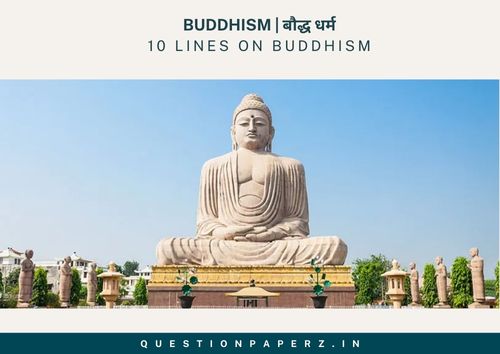Write 10 lines on Buddhism. Hi there! Today, I’m going to talk about Buddhism. It’s a really interesting religion that started a long time ago in Asia. The cool thing about Buddhism is that it teaches people how to be happy and peaceful. It was founded by a guy named Siddhartha Gautama, who is also known as the Buddha. People who follow Buddhism try to understand life better and find ways to stop suffering and be kind.
Contents
10 Lines on Buddhism in English Part 1
- Origin: Buddhism began in the 6th century BCE in what is now Nepal and India, founded by Siddhartha Gautama, later known as the Buddha.
- The Buddha: Siddhartha Gautama, upon attaining enlightenment, became the Buddha, which means “the awakened one”.
- Four Noble Truths: The central teachings of Buddhism are the Four Noble Truths, which diagnose the human condition and offer a method to overcome suffering.
- The First Truth: The truth of suffering (Dukkha) asserts that life in its usual state is full of suffering and dissatisfaction.
- The Second Truth: The truth of the cause of suffering (Samudāya) points out that the root of suffering is attachment, desire, and ignorance.
- The Third Truth: The truth of the end of suffering (Nirodha) offers hope by stating that it’s possible to end suffering.
- The Fourth Truth: The truth of the path to the end of suffering (Magga) outlines the Eightfold Path as the means to achieve enlightenment.
- The Eightfold Path: This path includes right understanding, thought, speech, action, livelihood, effort, mindfulness, and concentration.
- Karma: In Buddhism, karma refers to actions driven by intention which affect one’s future.
- Reincarnation: The cycle of rebirth and death, influenced by karma, is a fundamental concept in Buddhism.
10 Lines on Buddhism in English Part 2
- Nirvana: The ultimate goal in Buddhism is Nirvana, a state of liberation and freedom from suffering and the cycle of rebirth.
- Sangha: The Buddhist community of monks, nuns, and laypeople is known as the Sangha.
- Three Jewels: Buddhists take refuge in the Three Jewels: the Buddha, the Dharma (teachings), and the Sangha.
- Meditation: Meditation is a key practice in Buddhism, aiding in the development of mindfulness and insight.
- Diverse Traditions: Buddhism has diverse traditions and schools, including Theravada, Mahayana, and Vajrayana.
- Mahayana Buddhism: This branch emphasizes the path of a Bodhisattva, seeking enlightenment for the sake of all beings.
- Theravada Buddhism: Often considered the oldest Buddhist tradition, it focuses on individual enlightenment and the Pali Canon as its scriptural foundation.
- Vajrayana Buddhism: Also known as Tibetan Buddhism, it incorporates complex rituals and practices, including the use of mantras and mandalas.
- Zen Buddhism: A school of Mahayana Buddhism, Zen emphasizes the practice of meditation and the direct experience of enlightenment.
- Influence on Culture: Buddhism has significantly influenced Asian cultures, especially in arts, architecture, philosophy, and literature.
5 Lines on Buddhism
- Global Spread: From its origins in Asia, Buddhism has spread worldwide and adapted to various cultures.
- Modern Interpretations: Buddhism has been interpreted in contemporary contexts, addressing modern issues like environmentalism and psychology.
- Festivals and Holidays: Buddhist festivals vary by region and include Vesak, the celebration of the Buddha’s birth, enlightenment, and death.
- Ethical Practices: Buddhism promotes ethical practices and virtues such as non-violence, compassion, and generosity.
- Science and Buddhism: Many modern Buddhists and scholars find compatibility between Buddhism and scientific inquiry, particularly in understanding the mind and consciousness.
10 Lines on Buddhism in Hindi |बौद्ध धर्म के बारे में 10 हिंदी पंक्तियाँ
- बौद्ध धर्म एशिया में उत्पन्न हुआ एक प्राचीन धार्मिक परंपरा है।
- इसकी स्थापना सिद्धार्थ गौतम ने की थी, जिन्हें बाद में बुद्ध कहा गया।
- बौद्ध धर्म के चार आर्य सत्य हैं जो जीवन की सच्चाई बताते हैं।
- इसमें दुःख का सत्य, दुःख का कारण, दुःख का निरोध, और दुःख से मुक्ति का मार्ग शामिल है।
- बौद्ध धर्म में आठगुणी पथ का बहुत महत्व है, जिसके द्वारा मनुष्य ज्ञान प्राप्त कर सकता है।
- कर्म का सिद्धांत भी इस धर्म में महत्वपूर्ण है, जो हमारे कार्यों के परिणामों को बताता है।
- निर्वाण, जो बौद्ध धर्म में उच्चतम लक्ष्य है, वह दुःख से मुक्ति और आत्मज्ञान की अवस्था है।
- संघ, यानी बौद्ध समुदाय, इस धर्म का एक महत्वपूर्ण भाग है।
- बौद्ध धर्म में ध्यान का अभ्यास केंद्रीय महत्व रखता है।
- यह धर्म विश्व भर में फैला हुआ है और इसने कई संस्कृतियों को प्रभावित किया है।
Conclusion:
So, that’s a bit about Buddhism. It’s all about finding peace, being kind, and understanding life. Buddhists follow the teachings of the Buddha to learn how to be better people and live a happier life. It’s not just a religion; it’s a way of understanding the world and ourselves. I think it’s pretty awesome how Buddhism teaches us to be mindful and caring towards others and ourselves.
You can check our other 10 lines posts/articles for children and Students here. Do let us know if you have some comments and suggestions.

